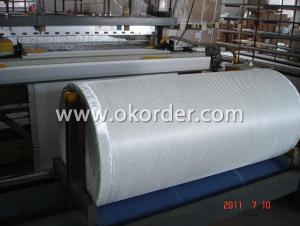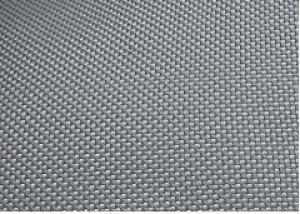High Quality China High Silica Fiberglass Fabric Roll
- Loading Port:
- China Main Port
- Payment Terms:
- TT OR LC
- Min Order Qty:
- -
- Supply Capability:
- -
OKorder Service Pledge
Quality Product, Order Online Tracking, Timely Delivery
OKorder Financial Service
Credit Rating, Credit Services, Credit Purchasing
You Might Also Like
Quick Details
| Place of Origin: | Brand Name: | Model Number: | |||
| Application: | Weight: | Surface Treatment: | |||
| Width: | Weave Type: | Yarn Type: | |||
| Alkali Content: | Standing Temperature: | product: | |||
| Colour: | Length count: | Thread count: | |||
| Endurance of temperature: | Instantaneous temperature: |
Packaging & Delivery
| Packaging Detail: | carton |
| Delivery Detail: | 15days |
Specifications
high silica fiber cloth
1.SiO2=96%
2.Work temperature 1100
3.Thermal insulationg
4.Heat protectio
high silica fiber cloth
1.SiO2=96%
2.Work temperature 1100
3.Thermal insulationg
4.Heat protection
- Q: Can fiberglass fabrics be used for reinforcement in architectural structures?
- Yes, fiberglass fabrics can be used for reinforcement in architectural structures. Fiberglass is a strong and lightweight material that has high tensile strength and excellent resistance to corrosion, making it ideal for reinforcing various architectural elements. It is often used in the construction industry to reinforce concrete structures such as walls, beams, and columns. Fiberglass fabrics can be embedded into concrete to increase its strength and durability, providing additional support and reducing the risk of cracking or structural failure. Additionally, fiberglass fabrics are flexible and can be easily molded or shaped to fit different architectural designs and structures. Overall, fiberglass fabrics are a versatile and reliable choice for reinforcement in architectural structures.
- Q: Are fiberglass fabrics resistant to mold or mildew?
- Fiberglass fabrics possess a general resistance to mold or mildew due to their non-porous nature and the fact that they do not foster ideal conditions for the growth of mold or mildew. They find common use in moisture-resistant applications, such as outdoor furniture, boat covers, and shower curtains. It is important to bear in mind, however, that while fiberglass fabrics themselves resist mold or mildew, the presence of organic materials like dirt, dust, or other organic matter on their surface can still provide an opportunity for such growth. Therefore, it is advisable to regularly clean and maintain fiberglass fabrics to ensure their longevity and resistance to mold or mildew.
- Q: Can fiberglass fabric be used for reinforcement in water treatment tanks?
- Indeed, water treatment tanks can benefit from the utilization of fiberglass fabric as a reinforcement. With its exceptional strength and durability, fiberglass emerges as an ideal material that exhibits resistance towards corrosion and chemicals, rendering it highly suitable for water treatment purposes. By offering structural reinforcement to the tanks, fiberglass guarantees their stability and longevity. Furthermore, the lightweight nature of fiberglass fabric facilitates easy installation, making it a cost-effective solution for reinforcing water treatment tanks.
- Q: Can fiberglass fabrics be used for reinforcement in building panels?
- Yes, fiberglass fabrics can be used for reinforcement in building panels. Fiberglass is a strong and lightweight material that is commonly used in construction due to its excellent strength-to-weight ratio and durability. When used as a reinforcement in building panels, fiberglass fabrics can provide additional structural integrity and enhance the overall strength of the panel. The fabric is typically embedded within a resin matrix, such as epoxy or polyester, to create a composite material that is strong, rigid, and resistant to various environmental factors. Additionally, fiberglass fabrics can be easily molded or shaped into complex forms, making them suitable for reinforcement in a variety of building panel applications.
- Q: Is fiberglass fabric easy to cut and sew?
- Yes, fiberglass fabric is relatively easy to cut and sew. Its thin and flexible nature allows for clean cuts and smooth sewing, making it manageable for various projects. However, it is important to take necessary precautions such as wearing appropriate protective gear and using sharp tools to ensure safety during cutting and sewing.
- Q: Can fiberglass fabric be used for making molds?
- Yes, fiberglass fabric can be used for making molds. It is a popular choice due to its strength, durability, and ability to easily conform to different shapes. Fiberglass fabric is commonly used in the mold-making process to create lightweight, yet sturdy molds for various applications such as in the automotive, aerospace, and construction industries.
- Q: How does fiberglass fabric perform in fatigue resistance?
- Fiberglass fabric is known for its excellent fatigue resistance. Its strong and durable properties make it highly resistant to cyclic loading and repetitive stress, allowing it to withstand repeated mechanical or thermal stress without significant degradation. This makes fiberglass fabric a preferred choice in applications where fatigue resistance is crucial, such as in aerospace, automotive, and marine industries.
- Q: Can fiberglass fabric be used for reinforcement in septic tanks?
- Yes, fiberglass fabric can be used for reinforcement in septic tanks. It is a strong and durable material that can provide added structural support to septic tanks, helping to prevent cracks and leaks.
- Q: What is the weight of fiberglass fabric?
- The weight of fiberglass fabric may differ based on the particular type and thickness of the fabric. Typically, fiberglass fabric is quantified in ounces per square yard (oz/yd2) or grams per square meter (g/m2). Fiberglass fabric is typically available in weights ranging from 0.5 oz/yd2 (17 g/m2) to 3.0 oz/yd2 (102 g/m2) or beyond. Lightweight fiberglass fabrics are often employed in applications like reinforcement and lamination, whereas heavier fabrics find common use in structural reinforcement or insulation objectives.
- Q: What are the main properties of fiberglass fabric?
- The main properties of fiberglass fabric include high tensile strength, excellent heat resistance, good dimensional stability, and strong chemical resistance. It is also lightweight, durable, and has low thermal conductivity. Additionally, fiberglass fabric is non-flammable and provides good insulation properties.
Send your message to us
High Quality China High Silica Fiberglass Fabric Roll
- Loading Port:
- China Main Port
- Payment Terms:
- TT OR LC
- Min Order Qty:
- -
- Supply Capability:
- -
OKorder Service Pledge
Quality Product, Order Online Tracking, Timely Delivery
OKorder Financial Service
Credit Rating, Credit Services, Credit Purchasing
Similar products
Hot products
Hot Searches
Related keywords
























